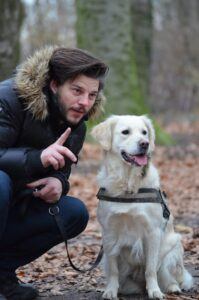I’m going to kick things off by talking about the bedrock of any pet’s social life: early socialization. If you want to steer clear of future issues like fear or aggression towards new buddies—be they furry or human—early introduction is your best bet. It’s not just about avoiding the bad stuff; it’s also about building a positive foundation from which your pet can grow into a sociable, well-adjusted individual.
You’re going to find out that timing is everything. Puppies and kittens, much like human tots, have a golden period when their little brains are spongy, soaking up experiences like a sieve. Introduce them early to other animals and people in a positive light, and you’re setting them up for a lifetime of tail wags and purrs around new friends.
But how do you encourage Rover to be amiable or Mittens to play nice? Enter positive reinforcement, which, in my opinion, is like the secret sauce to pet training. A little treat here, an affectionate pat there, and voila—you’re reinforcing their star-studded social performances. Such rewards can solidify those moments when your pet is Mr. or Ms. Congeniality.
However, don’t plunk your pet down in the middle of a bustling dog park or a loud family reunion from the get-go. That’s going to include some gradual and strategic introduction to new faces and places; more on that a bit later. For now, just remember that early socialization isn’t about throwing your pet into the deep end. It’s about dipping paws into the social waters—one toe at a time.
Creating Positive Social Experiences
Stepping into the realm of pet socialization isn’t just about introducing your pet to new faces; it’s about cultivating a sense of ease and trust in various settings. To do so, you’re going to find out about techniques that integrate gradual exposure, which is a critical component of a successful socialization protocol.
Initiating this process involves a delicate balance. Think of it like slowly turning up the volume on a speaker—it’s gentle, steady, and doesn’t startle or overwhelm. You’ll want to introduce your pet to different environments and new animals incrementally, ensuring each experience is as stress-free as possible. Begin in quieter, more controlled settings before venturing into crowded or noisy situations.

But remember, exposure alone isn’t enough. It’s vital to keep an eye on every meet-and-greet. Supervised interactions are the linchpin in early socialization. It’s akin to being the director of a play where your pet is the leading actor. You’re there to guide, protect, and direct the scene to ensure it’s enjoyable for all participants.
The key to all of this? Consistency. Pets thrive on routine and predictability. To truly engrain positive behaviors and social habits, stick with a regular schedule. This regularity eliminates confusion and makes it clear what’s expected of them, building confidence along the way.
Moreover, don’t limit your pet’s social curriculum to one kind of animal or environment. Diversity is your friend here. Expose them to dogs, cats, and people of different ages and appearances, and in varying contexts, from quiet parks to spirited doggy daycares. Each new encounter teaches your pet a vital lesson that contributes to their overall social acumen.
Understanding and Interpreting Pet Signals
You’re going to find out about one of the most crucial aspects of pet socialization – understanding and interpreting your pet’s body language. This isn’t just about creating a bond; it’s also about ensuring the safety and comfort of your pet during social interactions.
Learning to read your pet’s body language gives you a front-row seat to their feelings. It’s the nonverbal cues that tell you when they’re happy and relaxed or when they’re feeling stressed and in need of a little space. It’s all in the tail wags, ear positions, and even the subtle shifts in posture.
Recognizing your pet’s comfort and stress signals allows you to manage social situations effectively. For instance, a relaxed body and a wagging tail usually mean your pet is comfortable, whereas tucked ears and a lowered body might signal discomfort or fear. By picking up on these cues, you can intervene to prevent negative interactions before they escalate.
If you ever get stumped, there’s a wealth of resources and professionals who can help you learn. I’m here to help you understand the basics, but a professional behaviorist can offer deeper insights into your pet’s specific mannerisms.
Staying attuned to how your pet communicates can transform socialization from a challenge into a gratifying journey. Choose something that resonates with you and your pet; after all, each animal is unique and will communicate differently.
Overcoming Socialization Challenges
Socializing your pet can sometimes feel like navigating a complex maze, but with patience and perseverance, you’re going to find out about meaningful ways to build trust and camaraderie between your pet and the world around them. Remember, every pet moves at their own pace, and it’s crucial to respect that. Link challenges to opportunities for growth rather than seeing them as setbacks.
If you encounter hurdles in socializing your pet, don’t worry too much about it. Challenges are a natural part of learning and growth. Sometimes, despite our best efforts, our pets might not react as we expect. When this happens, the best approach is to take a step back, reassess the situation, and adjust your methods accordingly. You can always consult a professional trainer or behaviorist to get tailored advice that suits your pet’s unique needs.
Finally, integrate socialization into your pet’s routine to ensure they continue to develop their social skills. This doesn’t have to be an overwhelming task. Simple, regular interactions, such as walks in the park, visits to a friend’s house, or playdates with other pets, can all serve as fantastic opportunities for your pet to practice and maintain their social graces.
 In my opinion, the rewarding journey of pet socialization not only enhances your pet’s quality of life but also strengthens the bond you share. It allows them both to enjoy more of life’s adventures together. So, choose something that resonates with you and your furry friend, and embark on the beautiful path of social learning – it’s bound to be filled with joy and a few good stories to tell along the way.
In my opinion, the rewarding journey of pet socialization not only enhances your pet’s quality of life but also strengthens the bond you share. It allows them both to enjoy more of life’s adventures together. So, choose something that resonates with you and your furry friend, and embark on the beautiful path of social learning – it’s bound to be filled with joy and a few good stories to tell along the way.


Thank you for sharing your insight into pet behavior and how to work with it, while increasing your bond with the furry ones that we adore. I own 3, a bulldog/golden retriever, a chueweenie and a Husky Malamute. The little one we had was young, the other 2 were adopted. What would you recommend to those who have chosen the adoption route? I can imagine it has its own set of obstacles to go through.
Dear Nathan,
Thank you for the message. I appreciate any communication my blogs will bring and interest in my subject.
The most special pet I have ever possessed was a mixed breed, but mainly Golden Retriever, who I adopted when she was about 2 years old. She came from a loving family, who had to relocate and could not take her with them. Somehow animals know when they are loved, and she certainly gave me as much love as I could give her,
Your dogs are lucky, as they appear to have found a loving home,
Your message inspired me, and I am busy writing an article on adopted pets, which I hope to publish early next week.
Kind regards Tim